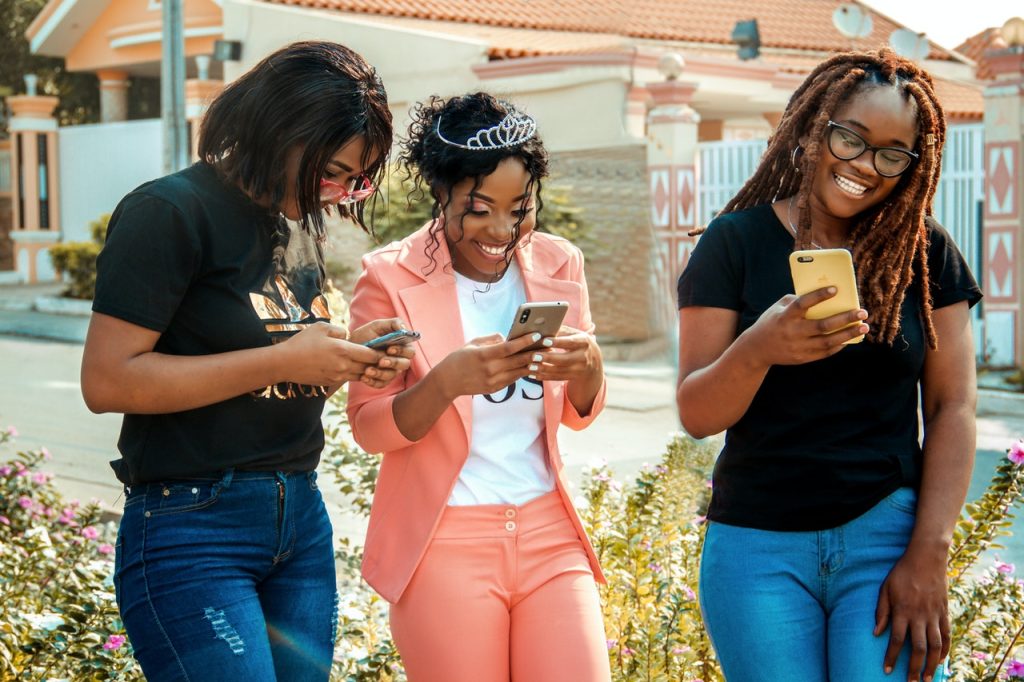The impact of internet platforms on the expression and development of gender identity.
Introduction
Contemporary life is inextricably linked to internet technology; particularly as its developments have become intertwined with the essential elements of the human experience. The decentralised nature of the internet has redefined contemporary social connections through the emergence of social media platforms that characterise Web 2.0 (Nixon, 2012). The platformisation of the internet has significantly influenced the private development and public expression of identity. The omnipotence of social media platforms in contemporary social connection has thus forced the feminine identity into an echo chamber and filter bubble, in which what is expressed determines what is popular, but what is popular depends on what is expressed.
In examining the architecture of social media platforms, notably Instagram, it becomes evident that online communities idealise particular feminine qualities. The resulting romanticised identities are magnified by feedback and engagement metrics and projected through the algorithmic curation of content (Duffy et al., 2019). The social capital generated through this process grows exponentially due to the networked effects of Instagram and is subsequently converted into economic value, triggering the enterprise and commercialisation of identity. This phenomenon is best examined through the manifestation of gender identity and the role of the ‘influencer’. What results is a perpetual loop, where the expression and development of gender identity occur symbiotically.
The online community
Humans are inherently social creatures; often believing that our identities are solely innate and distinct. However, sociological theory posits that our self-presentation is determined by our social circles, leading us to adapt our behaviour accordingly in an effort to gain acceptance (Goffman, 1973). Instagram’s online communities provide users with “a safe space for inspiration and expression”, fostering a sense of belonging that is invaluable to the development of identity in contemporary settings. Decisions about how we project our identities within an online community are influenced by the ideals it cultivates, and are driven by the popularity of the personal brands of others (Bullingham & Vasconcelos, 2013).

Platform Architecture
Krijnen and Bauwel (2015) infer that the cycle of influence and expression of gender identity is not an exclusively social media-driven phenomenon. While the role of traditional, pipeline-structured media cannot be understated, the internet has consumed modern social function to an unprecedented extent, that is significantly more potent by comparison. The decentralised nature of social media platforms allows a larger scope for contribution to gender discourse than ever before. Consequentially, Instagram contributes to the production of contemporary gender culture, a direct result of the diversity projected by the heterogeneity of its users (Duguay, 2022).
The portrayal of femininity is the principal expression of gender identity for women on Instagram, manifesting through the trends of feminine aesthetics (Butkowski et al., 2020). Feminine-centric trends redefine the image of the modern woman, through the creation of social media-esque stereotypes that define and connect online communities (Baker & Walsh, 2018). This has resulted in traditionally feminine traits being approached through postmodern and neoliberal feminist values, withdrawn from the conventions assigned to women in traditional media (Roberti, 2022).
Likes, Comments, and Followers; The Role of Engagement
Engagement metrics on social media dictate the algorithmic curation of content for users, thus informing the way individuals develop their sense of self as well as the way they express it. On Instagram, likes, comments, and followers serve as digital manifestations of human connection, symbolically reflecting the validation essential to the intrinsic development of identity (Bullingham & Vasconcelos, 2013). Engagement metrics define the popularity of content, trends, and user accounts on Instagram; therefore dictating the ‘ideal’ identity. Chiara Ferragni is one of the most popular influencers on Instagram, boasting almost 30 million followers on the social media platform. Her popularity, defined by her incredible engagement metrics, contributes to the domination of neoliberal feminist values that idealise the contemporary female identity (Roberti, 2022).

Butkowski et al. (2020) describe how the inherent social value of engagement metrics influences the expression of gender identity in young women on Instagram. They highlight that through attempts to align with the status quo, girls project “idealised self-representations”.
“Young women tend to emulate feminine ideals…”
(Butkowski et al. 2020)
the almighty Algorithm
The algorithmic design of social media platforms is another vital component of platform architecture that impacts gender identity. The Instagram algorithm characterises the content feeds of users based on the metrics of engagement, providing them with content that aligns with their interests (Cotter, 2019). Thus, the popularity of certain depictions of gender identity grows exponentially; a by-product of the network effects of social media platforms (Duguay, 2022). The ‘filter bubbles’ created by these algorithmic curations are responsible for a new range of female aesthetic ideals (Sindermann et al., 2020), to a great degree that has influenced the physical presentation of real-world women, described as the “Instagram Face”. This contributes to a perpetual cycle of gender discourse, explained by Duffy and Pruchniewsk (2017) as the “digital double-blind”; where women’s gender identity and the way in which this is presented online is determined by the feminine ideals that are dominant, but what is dominant is determined by what is presented.
Moderation

Content moderation is an important consideration when discussing the algorithmic curation of content on Instagram, and the effect this has on gender identity. Duguay (2022) asserts that the removal of content, particularly content displaying female nudity, has the ability to “remove the voice” of users. The freedom for women to express their sexuality is fundamental to the empowerment and liberation that define the postmodern feminist movement (Roberti, 2022). Social media platforms offer a space for individuals to contribute to the discourse surrounding the censorship of women’s bodies, as seen above in Chiara Ferragni’s Instagram post.
The Influencer and the #Adv
The ability of social media to categorise users into identity-based groups, or tailored audiences, has largely facilitated the fast-paced commercialisation of online spaces (Duffy et al., 2019). As social media became the dominant realm of internet use on the World Wide Web, the commercial identity of the “Influencer” emerged. The social capital generated through engagement metrics began to hold up as economic capital, and thus, individuals and businesses alike had the potential to profit from online identities (Janssen et al., 2022). While the pipeline structure of traditional media also utilised the identity of celebrities as commercial assets and marketing tools, the omnipotence of social media platforms in contemporary social connection left the personal brand at the nexus of the ideal female identity (Krijnen & Bauwel, 2015).

Through influencers, brands were able to directly connect with consumer markets that had been algorithmically curated thanks to Instagram’s online communities. Influencer endorsements on Instagram posted under #adv, receive high levels of engagement which consequentially allows them to dominate the feeds of users (Janssen et al., 2022). In accordance with Goffman’s (1973) theory of the presentation of self, we conform to fit into what we see as widely accepted. The validation and social capital that social media feedback generates, drive women to present themselves in a way that aligns with these presentations. When you consider the projection of femininity embedded into sponsored posts, it becomes clear how platformisation allows businesses to contribute to gender discourse on Instagram (Baker & Walsh, 2018).
Conclusion
Instagram expands on the ideal of freedom and connection that founded the internet and triggered its platformisation (Kelty, 2014). In doing so, it creates a new realm for expressing gender identity while simultaneously defining the ideals to which individuals should align themselves. The social domination of Instagram creates a vacuum in which the pervasive projections of brands and influencers alike, promote the commercialisation of the feminine identity in a way distinguished from anything seen before. This perpetual cycle of influence and expression of gender identity on platforms like Instagram contributes to the production of a new gender culture. While we like to think that we are who we are because of an innate, unique identity, the reality is that we are defined by the omnipotence of the platformed internet.
Bibliography and sources.
Baker, S. A., & Walsh, M. J. (2018). ‘Good Morning Fitfam’: Top posts, hashtags and gender display on Instagram. New Media & Society, 20(12), 4553–4570. https://doi.org/10.1177/1461444818777514
Bullingham, L., & Vasconcelos, A. C. (2013). ‘The presentation of self in the online world’: Goffman and the study of online identities. Journal of Information Science, 39(1), 101–112. https://doi.org/10.1177/0165551512470051
Butkowski, C. P., Dixon, T. L., Weeks, K. R., & Smith, M. A. (2020). Quantifying the feminine self(ie): Gender display and social media feedback in young women’s Instagram selfies. New Media & Society, 22(5), 817–837. https://doi.org/10.1177/1461444819871669
Cotter, K. (2019). Playing the visibility game: How digital influencers and algorithms negotiate influence on Instagram. New Media & Society, 21(4), 895–913. https://doi.org/10.1177/1461444818815684
Duffy, B. E., Poell, T., & Nieborg, D. B. (2019). Platform Practices in the Cultural Industries: Creativity, Labor, and Citizenship. Social Media + Society, 5(4). https://doi.org/10.1177/2056305119879672
Duffy, B. E., & Pruchniewska, U. (2017). Gender and self-enterprise in the social media age: a digital double bind. Information, Communication & Society, 20(6), 843–859. https://doi.org/10.1080/1369118X.2017.1291703
Duguay, S. (2022). Identity Modulation as Integral to Digital Citizenship. In S. Duguay, Personal but Not Private (1st ed., pp. 105–126). Oxford University Press. https://doi.org/10.1093/oso/9780190076184.003.0005
Goffman, E. (1973). The presentation of self in everyday life. The Overlook Press.
Janssen, L., Schouten, A. P., & Croes, E. A. J. (2022). Influencer advertising on Instagram: product-influencer fit and number of followers affect advertising outcomes and influencer evaluations via credibility and identification. International Journal of Advertising, 41(1), 101–127. https://doi.org/10.1080/02650487.2021.1994205
Kelty, C. (2014). The Fog of Freedom. In T. Gillespie & K. A. Foot, Media technologies: essays on communication, materiality, and society (pp. 196–220). the MIT Press.
Krijnen, T., & Bauwel, S. van. (2015). Power and Gender in the Media Industry. In Gender and media: representing, producing, consuming (pp. 93–106). Routledge, Taylor & Francis Group.
Meta. (2023). Community Guidelines. Instagram Help Center. https://help.instagram.com/477434105621119
Nixon, P. (2012). Girl Wide Web 2.0: Revisiting Girls, the Internet and the Negotiation of Identity. Information, Communication & Society, 15(1), 148–149. https://doi.org/10.1080/1369118X.2011.570359
Oxford University Press. (2023). Definition of Influencer noun from the Oxford Advanced Learner’s Dictionary. Oxford Learner’s Dictionary. https://www.oxfordlearnersdictionaries.com/definition/english/influencer#:~:text=%2F%CB%88%C9%AAnflu%C9%99ns%C9%99(r)%2F,recommending%20it%20on%20social%20media
Roberti, G. (2022). Female influencers: Analyzing the social media representation of female subjectivity in Italy. Frontiers in Sociology, 7. https://doi.org/10.3389/fsoc.2022.1024043
Sindermann, C., Elhai, J. D., Moshagen, M., & Montag, C. (2020). Age, gender, personality, ideological attitudes and individual differences in a person’s news spectrum: how many and who might be prone to “filter bubbles” and “echo chambers” online? Heliyon, 6(1). https://doi.org/10.1016/j.heliyon.2020.e03214
Tolentino, J. (2019, December 12). The Age of Instagram Face. The New Yorker. https://www.newyorker.com/culture/decade-in-review/the-age-of-instagram-face



